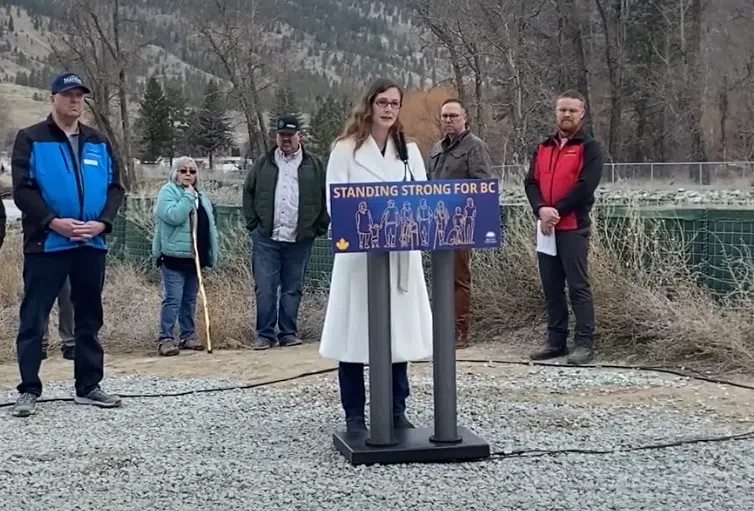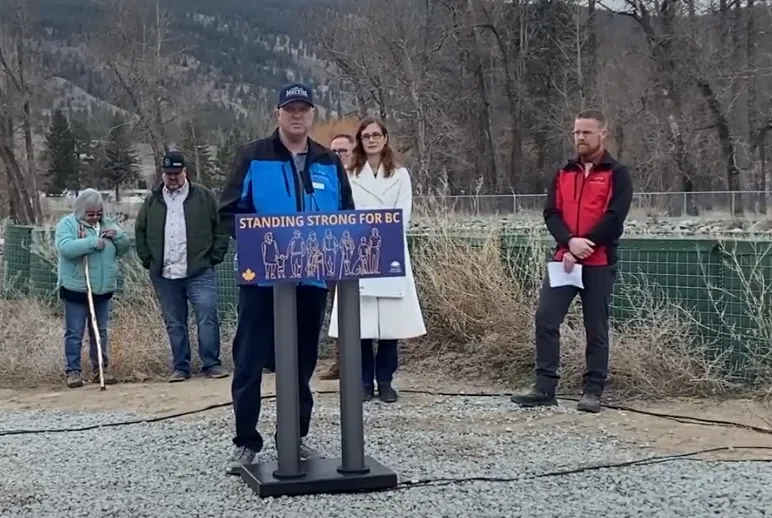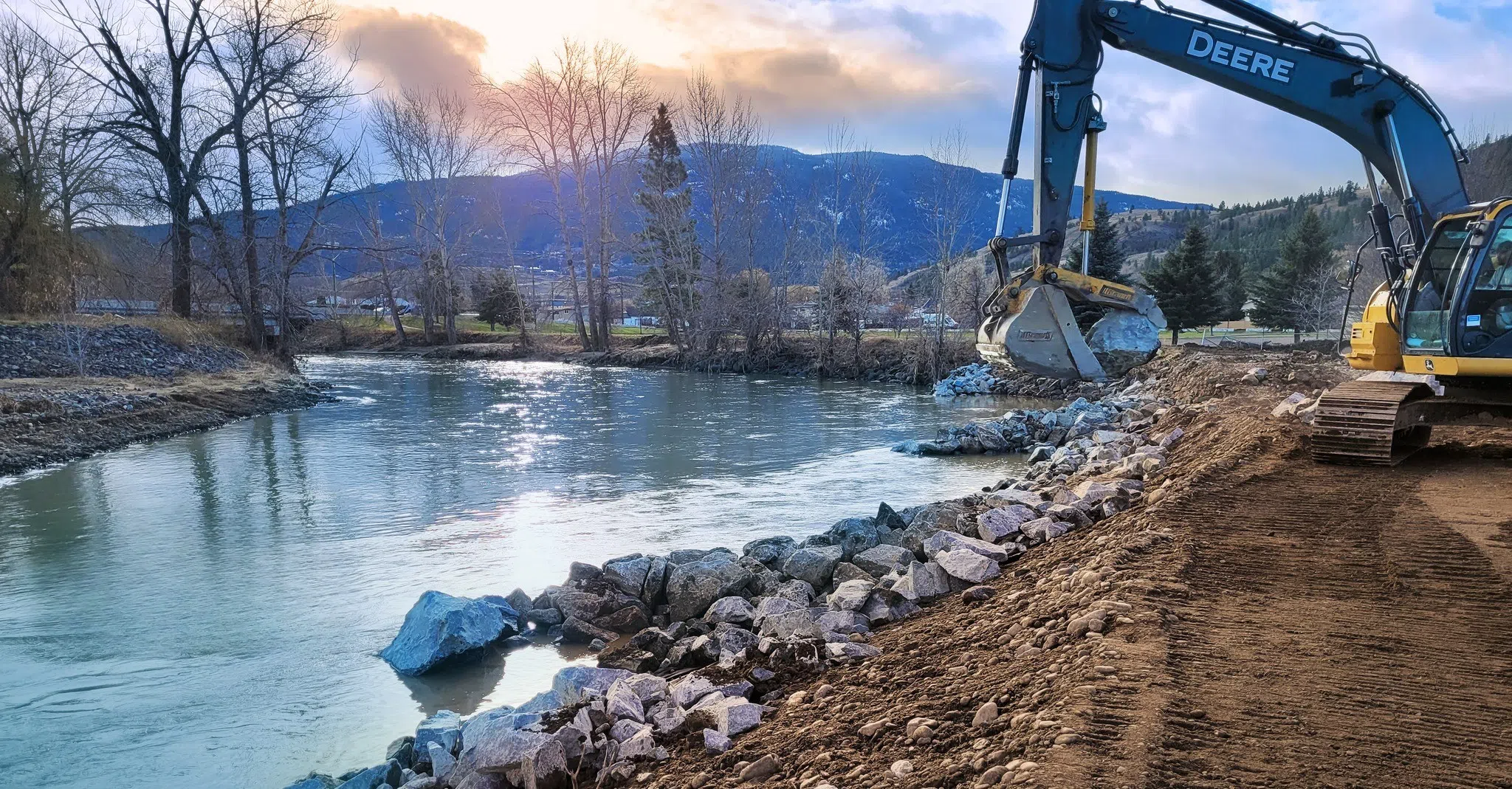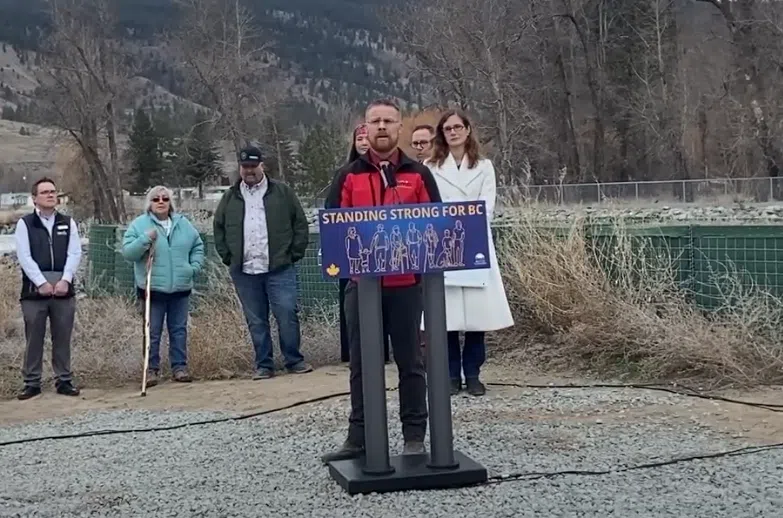
Emergency Managment and Climate Readiness Minister Kelly Greene in Merritt for $60 million flood mitigation announcement/via City of Merritt
The BC government has once again stepped up to the plate to help provide critical infrastructure protection in Merritt — all as the mayor of the community continues to wonder aloud when the federal government will live up to its post-flood promises.
Emergency Management and Climate Readiness Minister Kelly Greene, who has taken over the portfolio from Bowinn Ma in the new government, was on hand in Merritt on Tuesday to announce $60 million in funding for dike repair and restoration along the Coldwater River.
Both of the dikes, known only as non-descript numbers 129 and 130, are said to be the critical components of the effort in Merritt and the current administration under Mayor Mike Goetz to try to ensure there isn’t a repeat of the 2021 atmospheric river event which caused widespread damage to many parts of the community.
“It’s critical infrastructure,” noted Goetz as part of a Tuesday afternoon news conference with the new Emergency Management Minister, the Chief of the Shaken Indian Band, Lindsay Tighe and the City’s point person on the flood rebuild, Recovery and Mitigation Director Shawn Strang.
“We know this will protect our community as we grow,” said Goetz, who also took time to note that the time it’s taking to rebuild the diking system along the Coldwater River is holding back development. “It’s hard for investment in this end of the community when there’s the potential of flooding.”
“This will go a long way to help us out with that,” added Goetz.
Because of the intensity of the atmospheric river which plowed through Merritt and other parts of the Southern Interior in November of 2021, the normally docile Coldwater River blew through decades-old dikes.
This means they can’t be rebuilt in the same location, as the intensity of the Coldwater River at the time fundamentally altered its downstream path, meaning dikes 129 and 130 will end up being partially new structures, but replacing and significantly upgrading the existing fortifications as well.
The 2.9-kilometers worth of diking will essentially run from the recently reopened Middlesboro Bridge to the confluence of where the Coldwater and Nicola Rivers meet in Merritt.
It represents about three-fifths (60%) of what the City of Merritt’s engineering analysis suggests will be needed to provide adequate protection if another 1-in-200-year event like November 2021 were to happen again.
Merritt still looking to Ottawa
In the aftermath of the disaster, the federal government was on the scene within days of people being able to return to Merritt, taking tours and lamenting the damage that had been done.
There were also promises of federal help for the broader rebuild of the region.
Since then, the City of Merritt has attempted to apply three separate times for funding from the federal government’s Disaster Mitigation and Adaptation Fund (DMAF) — all three times the application for grant funding for dike repair has been rejected.
The last rejection the City of Merritt, along with Princeton and Abbotsford, were told their applications were not accepted due to formatting issues on the application itself.

Merritt Mayor Mike Goetz addressing a Tuesday news conference announcing $60 million in provincial money for flood mitigation/via City of Merritt
“We realized that very early on that temporary fixes weren’t enough. We needed long-term. Very grateful that the Province has worked with us hand-in-hand. The province has always been there,” said Mayor Mike Goetz as part of his comments during the Tuesday announcement.
“We’re hoping that some of that will rub off on the federal government, and they see what’s happening here and throw their hat into the ring,” added Goetz. “We’re still waiting for that part. We haven’t seen that yet.”
The City of Merritt says just $2.3 million has been committed by Ottawa for the so-called STUWI(x) project, which is a land reclamation effort by the area First Nations to reclaim and rejuvenate land which was left behind following the change in the overall course of the Coldwater River.
The lack of federal funding for Merritt itself comes as the BC government, with its $60 million commitment on Tuesday, has so far invested over $130 million into Merritt’s recovery in the aftermath, and still has a fairly hefty bill ahead of it as well.
Under the current structure, the Provincial government pays to expropriate properties which are needed to develop critical infrastructure.
To restore and rebuild dikes 129 and 130, around 30 properties in Merritt will have to be bought out to make the dikes strong enough to withstand another 1-in-200-year event.
That initial buy out could end up being closer to $50 million.
All told, there could be dozens more properties which will have to be expropriated for Merritt to complete the diking work needed, which could end up costing closer to $75 million or higher.
Timelines dependent on policy decisions

Construction equipment along the Coldwater River in Merritt/via City of Merritt
Even with the injection of $60 million into the program at the end of March, there is little likelihood the construction of the dikes will get going this calendar year.
While the City of Merritt has been able to complete a lot of the engineering design needed to start building the dikes, there are a few factors still left to get past before construction can begin.
First is the acquisition of the land itself.
The City, according to its FAQ section of its dedicated flood page, suggests those properties which have been earmarked for a buyout will be getting a letter sometime in the coming weeks, informing them of the potential for expropriation.
However, no dollar figure is going to be attached to that notification.
The City says only after the final engineering specs are done will those properties that need to be purchased get a second letter, which will then provide details of how to deal with a 3rd party, which the City of Merritt is bringing in to handle the compensation process.
The other major hurdle Merritt has to overcome is environmental policy.
Due to concerns over salmon spawning and migration, as well as the available window of low water flows along the Coldwater River itself during the summer months, the City of Merritt says it has only an 11-day window each year to do the work needed on the banks of the Coldwater River and within the river itself to build up the protection barriers for close to 1,300 homes now sitting in a revamped flood plain left behind from November 2021.
The City of Merritt, through its FAQ section, suggests regulatory exemptions would help speed the process along.
With the current rules in-place, the estimate to complete construction of dikes 129 and 130 could be anywhere from 6 to 8 years, putting the completion of the projects somewhere in the range of 2032 to 2034.
As the City of Merritt works to try to shore up its own defenses, another policy decision still lingers in the background — responsibility for dikes and dams.
- Shaken Indian Band Chief Lindsay Tighe addressing the Tuesday news conference/via City of Merritt
- City of Merritt Recovery and Mitigation Director Shawn Strang addressing the Tuesday news conference/via City of Merritt
A then-BC government decision under the former BC Liberals in 2003 saw the province turn control over local waterway management — aka: dams and dikes — to lower levels of government, such as municipalities and regional districts, with the expectation they would be able to more closely monitor and manage them.
However, the cost of keeping them up was also thrust upon local governments as well.
Through the course of 20 years from that policy change, many of the earthwork projects, including the dikes in Merritt, fell into disrepair due to either a lack of funding and/or attention.
This was highlighted in a 2018 report which warned of the dangers Merritt faced if its diking systems on both the Coldwater and Nicola Rivers failed, as they did three years later.
Previous concerns about such issues had previously prompted calls from within the Union of BC Municipalities for the province to retake control the management and maintenance of local dikes and dams, both regulated and non-regulated.
Despite the overture, the provincial government then rebuffed the suggestion back then.
A similar rejection was put into a policy document at the start of 2024, again keeping the onus on local governments for upkeep and costs.
The provincial government — through the Ministry of Forests and the Inspector of Dikes — does maintain oversight over most of the roughly 200 regulated dikes in the province.
There are over 100 other so-called “orphaned dikes” which line certain waterways throughout BC.
The City of Kamloops is looking at a bill estimated at $115 million to maintain the dikes and small dams created as part of the BC Fruitlands Irrigation District, which the City took control over when North Kamloops was absorbed into Kamloops-proper in 1967.
Despite the financial burden facing communities like Kamloops and Merritt, there has been no signal suggesting the Eby government has any desire to change the status quo.

















